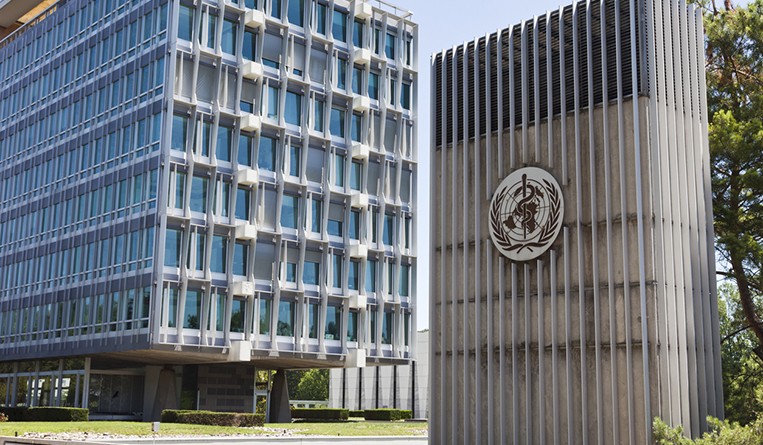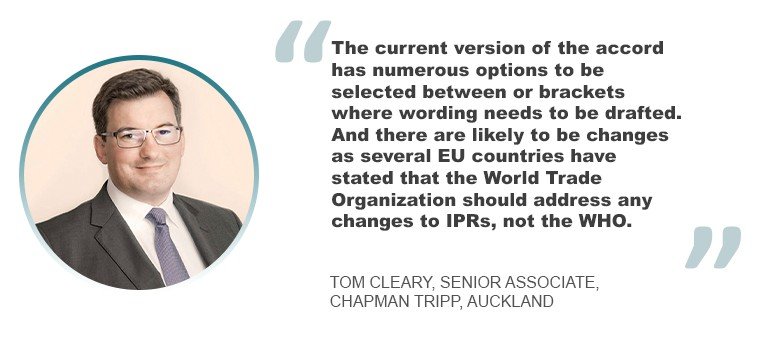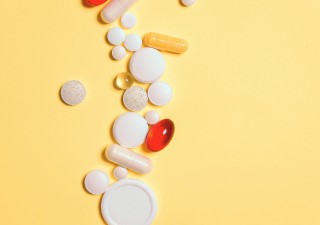A peek at the pandemic accord
30 April 2024

The World Health Organization’s Pandemic Accord aims to unify global response to future pandemics. Excel V. Dyquiangco findsagreement on resource-sharing and intellectual property remains elusive, but nations see its potential as a shield against future pandemics.
In December 2021, the member states of the World Health Organization (WHO) decided to establish a global process to draft and negotiate a convention, agreement or other international instrument for pandemic prevention, preparedness and response. This is known as the Pandemic Accord, which seeks to ensure that all governments, communities and the public and private sectors are better protected and prepared for future pandemics.
The texts of the accord are supposed to be finalized when WHO convenes in May 2024. However, because of the complicated nature of the negotiation process, it is no longer clear whether this timeline can be met.

According to Tom Cleary, a senior associate at Chapman Tripp in Auckland, under the current version of the accord, the member states of the WHO “might” agree to the following:
- Eight responsibilities of each member to prevent pandemics, including:
- Providing clean water, sanitation and hygiene;
- Reducing the risks of zoonotic spillover and spillback; and
- Laboratory biosafety and managing antimicrobial resistance (Article 4).
- To assist developing countries in preventing zoonotic spillover of diseases from animals to humans (Article 5).
- To strengthen healthcare systems, moving towards universal healthcare (Article 6) and maintaining a skilled healthcare workforce (Article 7).
- To report to the WHO every five years (Article 8).
- To support transparent and public sharing of research inputs and outputs from government-funded research and development pandemic-related products (Article 9).
- To encourage entities with public funding to grant non-exclusive, royalty-free licences to any manufacturers, particularly from developing countries, to use their IP to develop pre-pandemic and pandemic diagnostics, vaccines and therapeutics (Article 10).
- To pool IPRs and know-how and have time-bound waivers of IPRs to accelerate or scale up the manufacturing of pandemic-related products (Article 11).
- To form a multilateral system for access and benefit sharing for pathogens with pandemic potential by countries with access to such pathogens sharing the biological material as soon as available to one or more laboratories or biorepositories participating in WHO-coordinated laboratory networks (Article 12).
- To create a global supply chain network operated by the WHO in partnership with countries to avoid competition for resources among international procuring entities (Article 13).
“I say ‘might’ because the current version of the accord has numerous options to be selected between or brackets where wording needs to be drafted, and there are likely to be changes as several EU countries have stated that the World Trade Organization (WTO) should address any changes to IPRs, not the WHO,” Cleary said. “The EU has expressed concerns about clauses on IP, technology transfer and finance. Germany, Sweden, Ireland and the UK firmly opposed any provisions that might undermine IP protection. The U.S. has also signalled that IPR must be protected, with Articles 10 and 11 under attack.”
He added: “The Intergovernmental Negotiating Body (INB) is still developing the accord and the INB will submit its outcome to the WHO in May 2024. However, in January of this year, the head of the WHO said that there is a risk that this deadline will be missed. Importantly, even if the accord is agreed upon in May 2024, the accord itself does not empower the WHO to take action at a national level. The accord would bind the member states to act, and non-compliance can be raised with the WHO.”
When fully implemented
While waiting for the results of this proposal, what happens when this accord is now fully implemented? Tony Yeo, managing director of intellectual property and head of the healthcare and life sciences practice at Drew & Napier in Singapore, said that every state will have to decide whether to ratify the accord. If they choose to do so, they will need to decide how to implement the guiding principles outlined in the accord locally.

“The Zero Draft of the accord, dated February 1, 2023, sets out a number of potential guiding principles and rights but also expressly recognizes that states have the sovereign right to determine and manage their approach to public health, provided their activities within their jurisdiction or control do not cause damage to their peoples and other countries,” he said.
In Singapore, Article 7 of the Zero Draft aims to address the issue of inequitable access to pandemic-related products (including vaccines, therapeutics and diagnostics) and promote sustainable and equitably distributed production, technology and know-how.
“Regardless of whether the accord is eventually fully implemented, there are already some provisions under Singapore law which cater for a similar purpose,” said Yeo.
For example, Article 7(4) of the Zero Draft provides that parties to the accord will “take appropriate measures to support time-bound waivers of intellectual property rights that can accelerate or scale up manufacturing of pandemic-related products during a pandemic, to the extent necessary to increase the availability and adequacy of affordable pandemic-related products.”
“This is already possible under Section 56 of the Singapore Patents Act, which authorizes the Singapore Government (and any party authorized in writing by the Singapore Government) to do (a) anything in relation to a patented invention for a public non-commercial purpose, or (b) for or during a national emergency or other circumstances of extreme urgency,” said Yeo. “Anything done by virtue of Section 56 of the Singapore Patents Act will not amount to patent infringement. Whether the Singapore Government will exercise these powers in the event of a future pandemic remains to be seen.”
Cleary added that the accord requires each member state to strengthen healthcare systems “with a view to the progressive realization of universal health coverage” and establish or build on relevant laboratory networks “to conduct epidemiological genomic surveillance” and share information about emerging pathogens, including drug-resistant pathogens.
“So, there is likely to be some organizational changes and investment into healthcare (which there already has been) and further integration between laboratories, both nationally and internationally,” he said. “Subject to whether they are approved, we are also likely to see some amendments to IPR protections, particularly patent law, to provide for export sharing of vaccines or therapies for developing countries and also a time-bound waiver of certain IPRs during a pandemic.”
According to Cleary, as currently drafted, the accord would have three main impacts on IPRs in New Zealand. Firstly, it would require the sharing of pandemic-related information. While some information is readily available in various forms, the proposed change would involve valuable information that the generating organization might want to retain control over. This may have minor legal implications, depending on whether any control is placed on the information. Nevertheless, it would likely speed up access to diagnostics in New Zealand, reducing the country’s reliance on importing such diagnostics overseas as it did during Covid-19.
Secondly, the accord would “encourage” publicly funded organizations to grant free licences to manufacturers around technologies or IPRs relevant to pandemic response. Since most research organizations in New Zealand are publicly funded (at least in part), there is potential for significant IP to be provided freely for use in New Zealand and in developing countries. This change would be significant.
As it stands, Section 171 of the Patents Act 2013 allows the court to order non-exclusive licences for manufacturing and exporting pharmaceutical products (defined as medicine or vaccine, the active ingredient of such, or a diagnostic kit) to certain countries. However, this order may only be made if the WTO decides that the country needs pharmaceutical products and/or lacks the manufacturing capacity for the said products to address a public health problem. The accord suggests expanding this mechanism for publicly funded organizations in New Zealand. Rather than amending the patent law, which would be “messy,” the expansion could be achieved through conditions tied to public funding.
Lastly, the third impact would entail time-bound waivers of any IPR during a pandemic needed to accelerate or scale up manufacturing pandemic-related products. While New Zealand has a compulsory licence mechanism, this time-bound waiver approach is significantly broader and would limit IPRS rather than force a licence. A substantial change to patent law would be required to provide for this waiver approach.
“The accord would, therefore, address the concerns that existed that New Zealand had to separately bargain and wait its turn for diagnostic kits and vaccines,” Cleary said. “However, doing so would likely create concerns about the IPRs.”
He noted that New Zealand currently has some mechanisms to address some of these concerns:
- Section 171 allows a court to order a licence to manufacture medicines and pharmaceuticals for export to certain countries. This section only addresses the manufacturing capacity shortage in those countries and does not extend beyond that. It also requires remuneration.
- New Zealand also has compulsory licence provisions (Section 169) to address the lack of access on reasonable terms in the country and Crown use of inventions (Section 179), which would be relevant given the healthcare system in New Zealand is government-run. Thus, in cases where patents get in the way of accessing the necessary treatments in the country or where supplies are too expensive or unavailable due to worldwide shortages, these provisions could permit the manufacture and distribution of these treatments within the country, but again with reasonable remuneration.
Potential legal complexities and challenges
Yeo said that if the intellectual property provisions in the Pandemic Accord are to eventually be implemented in Singapore, one potential challenge would be to secure the buy-in of the various stakeholders and ensure that their concerns are met.
“Over the years, the Singapore Ministry of Law and the Intellectual Property Office of Singapore have conducted a number of public consultations to collate views from the various stakeholders on proposed changes (non-pandemic related) to the intellectual property regime in Singapore,” he said. “If it becomes necessary for the intellectual property regime in Singapore to change as a result of the accord, it is possible that similar public consultations will be conducted to ensure that the concerns of the various stakeholders are addressed while achieving the intended purposes of the accord.”
Ankita Sabharwal, an associate at Chadha & Chadha in New Delhi, added that the accord is a document aimed at safeguarding the diverse interests of 194 nations across the globe. Hence, the implementation of this treaty is undisputedly complex.
“Apart from disagreements regarding issues, such as resource allocation, enforcement mechanisms, equitability of resources, among others, the implementation of the accord also poses several other challenges,” she said. “These include the manner of information sharing between countries, which has not been effectively laid down in the draft. Moreover, enforcement of this treaty raises several challenges since the draft does not provide effective clarity on the mechanisms regarding accountability.”
To overcome these challenges, she noted that the draft is undergoing a process of revision and negotiations within the global community. “Countries are approaching the implementation of the Pandemic Accord through various strategies and initiatives aimed at translating the agreement’s principles into concrete actions. Some of these measures include legislative amendments, capacity building, surveillance and community engagement,” she said.
Sabharwal added that the Covid-19 pandemic underscored the reality that diseases transcend borders and territories, emphasizing the interconnectedness of global health.

“While the pandemic may have ‘officially’ concluded, it has left profound lessons for the international community. From revealing deficiencies in medical readiness to exacerbating economic disparities, it underscored the imperative that global safety hinges on collective security,” she said. “Consequently, nations worldwide recognized the necessity for establishing protocols and standards to enhance global resilience against future pandemics.”






